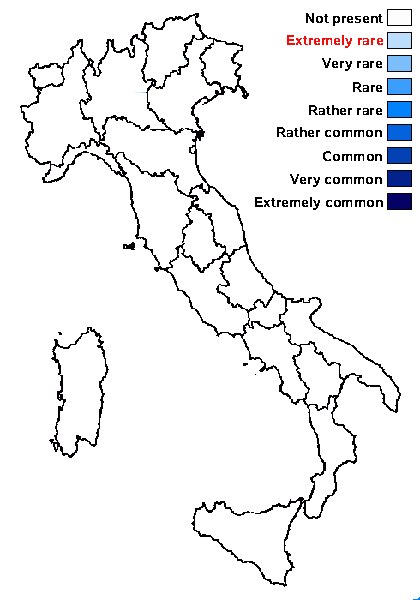Carbonea nivaria (Arnold) Hertel & Schuhwerk
Rambold ex Hertel & Schuhwerk, Bibl. Lichenol., 104: 170 ,2010 . Basionym: Lecidella nivaria Arnold - Verh. zool.-bot. Ges. Wien, 28: 283, 1878
Synonyms:
Distribution:
Description: Thallus crustose, episubstratic, rimose or areolate, the areoles (0.25-)0.4-0.5(-0.65) mm wide, pale grey to grey-white, sometimes with a slight brownish discolouration. Apothecia lecideine, black, epruinose, round to slightly irregular in outline, at first more or less immersed but soon sessile, single or in small clusters of 2-3, (0.13-)0.3-0.5(-0.7) mm across, with a flat to slightly convex, rarely umbonate disc and thin but persistent, more or less flexuose proper margin. Proper exciple of radiating hyphae, 25-40 μm wide in upper part, up to 120 μm wide in lower part, extending below the hypothecium, often with numerous tiny crystals (<0.5 μm diam.) visible in polarized light and soluble in K, dark blue-green in outer part, gradually paler within, K-, N+ purple-red; epithecium dark blue-green K-, C-, N+ red; hymenium colourless to greenish, especially in upper part, c. 55–65 μm high, sometimes with dark patches of a blue-green pigment, K-, K/I+ blue, N+ red; paraphyses sparingly branched and anastomosing, 1-2 μm thick, the apical cells up to 2.5 μm wide; hypothecium pale brown, K-, N-. Asci 8-spored, clavate, the K/I+ blue tholus penetrated by a faintly amyloid apical cushion with parallel or diverging flanks, the outer wall very thin, K/I-, surrounded by a K/I+ blue outer layer, Lecanora-type. Ascospores 1-celled, hyaline, broadly ellipsoid to subglobose, 6-9 x 4-6 μm, the wall c. 0.5 μm thick. Photobiont chlorococcoid, the cells 12-17 μm wide. Spot tests: thallus K+ yellow turning reddish or K-, C-, KC-, P+ red. Chemistry: pannarin and usually low amounts of norstictic acid.Note: this silicicolous species found on climatically rough ridges at high altitudes is only known from the Austrian Alps; to be looked for in the Italian Alps.
Growth form: Crustose
Substrata: rocks
Photobiont: green algae other than Trentepohlia
Reproductive strategy: mainly sexual

Predictive model
Growth form: Crustose
Substrata: rocks
Photobiont: green algae other than Trentepohlia
Reproductive strategy: mainly sexual

Predictive model

